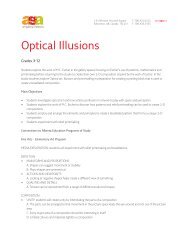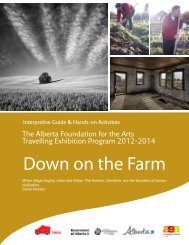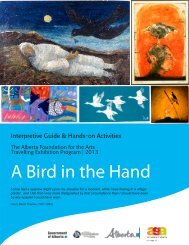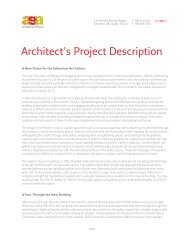Urban Animals - Art Gallery of Alberta
Urban Animals - Art Gallery of Alberta
Urban Animals - Art Gallery of Alberta
You also want an ePaper? Increase the reach of your titles
YUMPU automatically turns print PDFs into web optimized ePapers that Google loves.
The <strong>Alberta</strong> Foundation for the <strong>Art</strong>s Travelling Exhibition Program<br />
Geometry <strong>Animals</strong> K-3<br />
Objectives:<br />
Geometry <strong>Animals</strong> is a good project for young students to identify colours, textures, forms,<br />
and subjects in the environment. Students are expected to construct recognizable animals from<br />
shapes using a variety <strong>of</strong> colours, forms, and lines as well as use their imagination and creative<br />
expression to invent new forms.<br />
Begin by examining the shapes seen in any <strong>of</strong> the paintings by Jason Carter in the<br />
exhibition <strong>Urban</strong> <strong>Animals</strong><br />
Materials:<br />
• Glue<br />
• Coloured paper<br />
• Paper shapes<br />
• Crayons, coloured pencils or markers<br />
• Example reproductions <strong>of</strong> animals<br />
http://www.lessonplanspage.com/MathScience<strong>Art</strong>LAMDGeometry<strong>Animals</strong>K1.htm<br />
Procedure:<br />
1.Get materials ready before lesson starts.<br />
2.Introduce photographs or reproductions <strong>of</strong> recognizable animals and introduce basic shapes <strong>of</strong><br />
the animal with students.<br />
3.Point out shapes and ask kids to identify them.<br />
4.Show them the example animal you made.<br />
5.Discuss materials and proper gluing technique.<br />
6.Tell students that they will now be constructing their own animals using shapes.<br />
7.Hand out materials or have students grab them from your small group table or another table in<br />
the room.<br />
8.Allow time for students to work on their animals.<br />
9.Walk around the room asking students about their animals and encourage students to add<br />
texture onto their shapes using coloured marker.<br />
10.Have students count and write how many shapes they used and what colour they are.<br />
11.If you would like to, have students share.<br />
Closure:<br />
•Ask students how many shapes they used.<br />
•Ask them what colours they used.<br />
•Ask students about their animals.<br />
AFA Travelling Exhibition Program, Edmonton, AB. Ph: 780.428.3830 Fax: 780.421.0479<br />
youraga.ca

















